Reviewed by Glenn Erickson
TV's Mad Men brought the consumer-driven late '50s vibe back to the cultural fore, with button-down execs and ambitious secretaries finding their way in an office culture now all but completely eradicated. The show generated interest in older movies that (mildly) questioned the modes and morals of the glamorous but risky life to be found in the high-stakes jungle of New York City. Early in the show, advertising executive Don Draper is seen reading Rona Jaffe's exposé novel The Best of Everything, to find out what woman want. The title tells it all -- they wanted the good life that came from material success, which for women of the time meant the right marriage with the right provider. Ten years after Betsy Drake's matrimonial barracuda in Every Girl Should Be Married, young American women in popular novels were proclaiming their independence -- while trying to claim a Prince Charming for their own.
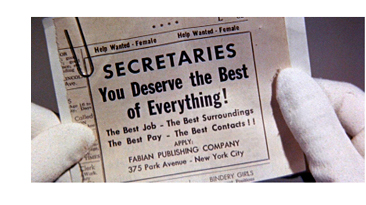
This 8-cylinder soap opera of a movie adaptation is a not-bad examination of the dilemma faced by smart, attractive young urban women, whose newfound options are still rather limited. The Best of Everything is producer Jerry Wald's follow-up to his mega-hit Peyton Place, yet another in the string of successes built around a multi-character story of modern morals. As explained in an interesting commentary by the original book author Rona Jaffe, Wald inspired her to write a spicy exposé of what life is like for modern working girls. He then pounded it into a box office-friendly and censor-safe Hollywood mold. What came out is pretty entertaining, with interesting actresses like Hope Lange and Diane Baker being run through the typing pool of a Manhattan publishing company like spawning salmon. Johnny Mathis sings a gushy title tune that starts the movie on a rather classy note. The opening scenes of the city behind his music are an interesting comparison with Alfred Hitchcock's for the same year's North by Northwest. Everywhere, in all directions, are stylish women on their way to work.
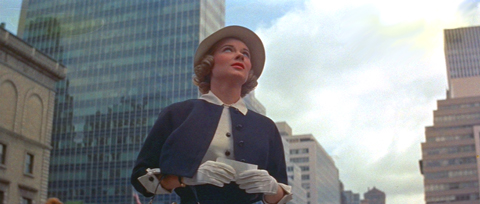
On her first day as a typist in a ritzy high-rise publishing house, fresh college graduate Caroline Bender (Hope Lange) finds two new roommates. Virginal Coloradan April Morrison (Diane Baker) escapes the grabby hands of editor-wolf Fred Shalimar (Brian Aherne), but also sees the encounter as a secret thrill. Worldly freeloader Gregg Adams (Suzy Parker) claims to be a cool player of the love game, yet suffers breakdowns both romantic and nervous over famous stage director David Savage (Louis Jourdan). Caroline must deal with her faithless fiancée (Brett Halsey) and locks horns with a hostile female editor, Amanda Farrow (Joan Crawford). All three women navigate an office atmosphere dominated by alcoholic married males that prey upon the young typing talent. April is eventually swept off her feet by Dexter Key, an oily playboy (oily playboy Robert Evans). Caroline must choose between a serious career and the interest of the one decent editor in the company, the philosophical Mike Rice (Stephen Boyd).
 (various spoilers)
(various spoilers)
Soap opera or no, The Best of Everything sustains high interest with its attempt to be honest about the new working girl. Although this was just prior to The Pill, in the late 1950s an awful lot of sexual freedom suddenly became acceptable -- and somewhat desirable -- in the urban centers. Nobody in this publishing house is separating the good girls from 'those that do.' It's presumed that Hope Lange's Caroline has had some amorous experience, and Suzy Parker has certainly been around the block more than once. Only young Diane Baker's April is assigned a role to appease the censor, as starlet Yvette Mimieux would in Where the Boys Are. Hollywood wouldn't let innocent young things just be seduced and abandoned; they had to go nuts in remorse and walk into traffic or leap from a moving car. Perversely, the unexpected unborn children were made to perish, both for closure and to provide a shameful punishment for the sinful young woman.
Although the girls get pinched, hit on, plied with liquor and lied to by a succession of heels, The Best of Everything does make it easy to distinguish the good men from the lice. Lecherous married fool Fred Shalimar likes to pounce on women as if they were deer in hunting season; these days big executives behaving as he does can sometimes be seen doing the perp walk on the 6 O'clock News. Fiancée Eddie puts in a casual call to let Caroline know he's married another girl for business reasons, and later makes a slimy proposition to keep her on the side. The verminous Dexter Key treats April like a disposable inconvenience, like Kleenex. The honest Eddie Rice is the sole male to behave in a gentlemanly manner, and that's only after our heroine has thrown herself at him in a moment of alcoholic despair. And Eddie still respects her the next day, even when he has to reassure her that nothing happened. Eddie never quite gels, as he combines pessimistic remarks with an altruistic attitude. But amazingly, it looks like he'll stop badgering Caroline to give up 'competing in a man's world.' Even if he holds a grudge, that's progress.
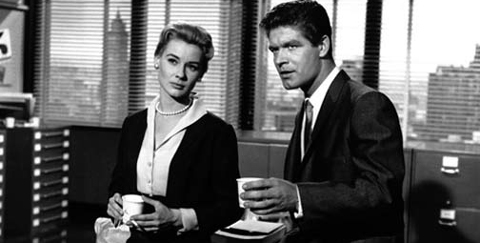
Author Jaffe originally included a wider range of women in her story. Martha Hyer's divorced mother is established in an unhappy relationship with yet another married staff member. But her subplot is severely limited, presumably because the grief of a single mom was apparently insufficiently glamorous. We never see her child. The book featured a fifth female character, but the movie eliminated her altogether, along with, reportedly, a gay character.
Joan Crawford is on board with an unusually subdued performance in a role given her as a favor by her old producer Jerry Wald. Crawford's Amanda Farrow is presented as a class-A bitch, a career roadblock to Caroline, but she also has a sad story to tell. Amanda later intimates that she tried to go away to become the quiet wife of a dull businessman, but it didn't work out. Crawford fans will immediately find a parallel with Crawford's own story. She'd recently buried her Pepsi-executive husband -- after spending him dry -- and was practically crawling back to Hollywood hoping to get her career going again. Try as she may, Crawford's acting style doesn't mesh with anything. But she at least doesn't try to upstage the younger actresses with garish glamour touches.
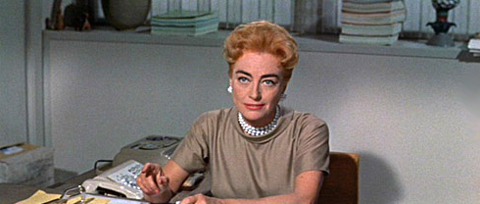
Caroline's progress remains the story's main thread. She becomes a reader and then an editor in a matter of days by flagrantly misrepresenting herself to work with a writer 'she believes in.' The movie makes no comment about this bit of chicanery. Caroline spends the rest of her time running interference for Diane Baker's deluded April and wondering what happened to Suzy Parker's Gregg, the office's worst train wreck.
(spoiler)
An actress on the side, the supposedly impervious Gregg goes nuts over Louis Jourdan's David Savage, a stage director that calmly accepts favors from the multitudes of women that throw themselves at him, body first. After David's rejection Gregg turns into a psycho stalker, hanging around his apartment and going through his garbage in search of anything to maintain her connection with him. Gregg is essentially an update of a character from The Lullaby of Broadway musical number in The Gold Diggers of 1935: like the 'Broadway Baby,' Gregg loves kittens, and takes an unplanned backwards dive from the top of a tall building.
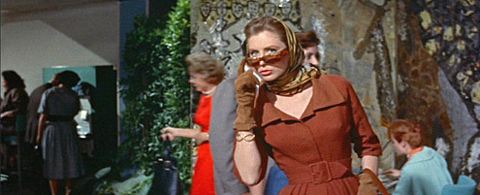
As for April, the sanitized script makes her an unwed mother double-crossed on what is supposed to be her wedding day. The story then confects a revolting censor-proof resolution that a) punishes April for her sins with undeserved violence and injury; b) gets rid of the inconvenient fetus; and c) instantly finds April a Mr. Right in the form of a devoted young doctor. This actor (Otis Wood) has no lines, clearly for budgetary reasons -- every time he's about to speak, somebody else does instead. The Doc falls in love with April as she lies wrapped up in bandages, like Miss Im-ho-tep, 1959.
I've had fun with the campier aspects of The Best of Everything but it's a highly entertaining show, and probably more sensitive to its characters than I've let on. Although Suzy Parker's performance won no praise Diane Baker is a cute addition to the Fox contract list, while Hope Lange once again carries the lead role with aplomb.
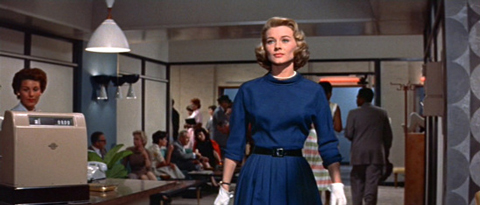
The Twilight Time Blu-ray of The Best of Everything is a quantum improvement over Fox's old 2005 DVD. Newer scanning technology has done a much better job of bringing back original color. That allows us to ponder Fox's house art direction choices, which since the 'forties leaned toward blues. The New York exteriors stress glass towers under sunny skies, with men in suits and women wearing heels and gloves. The colored panel decor in the office is pure Mad Men, with the layout of desks in the steno pool inviting comparison with the next year's The Apartment. Women viewers surely watched the film's clothes closely -- at any given time there are always seven or eight fashionable females on screen. An absorbing commentary alternates between author Rona Jaffe's personal reminiscences and info provided by historian Sylvia Stoddard. Stoddard's attention to detail goes a bit too far into fashion minutiae for this male reviewer, but otherwise she offers a lot of interesting information -- is the office design just Mondrian-like, or were people in 1959 referring to the style with that name?
The film's music by Alfred Newman is on its own Isolated Score Track.
Rona Jaffe's talk is fascinating. As can be expected, she enjoyed enviable connections to producer Wald that helped her get the job. But she explains in full how the book came about and how the movie diverged from it. Anecdotes contrasting her own experience working at a publishing house -- wasting time, lying about being qualified to take shorthand, etc. -- are hilarious. She does a fine job of explaining what the morals of her co-workers were like without resorting to sleazy details, or getting out the whitewash. This again contrasts with a later-generation tale of upwardly mobile college graduates aiming for success in publishing: Whit Stillman's The Last Days of Disco.
The old Fox DVD package carried a photo from the set of Joan Crawford and what would seem to be author Rona Jaffe. Crawford has her 'three p.m. plastered but looking good' smile; we can presume that the stage temperature is down in the '60s so she can guzzle vodka in a water glass and not break out in perspiration. The Pepsi bottle is right there too. Crawford is officially 'posing with someone important' and stares over the camera while holding Rona's hand. For her part, Ms. Jaffe looks like she wants to be rescued, fast. One picture is worth a lot of words. Rona reportedly performs a bit as one of the girls in the typing pool.
The extras retain a newsreel blurb covering the film's premiere. The original trailer gives special emphasis to a classic trashy Joan Crawford line of dialogue: "You and your rabbit-faced wife can both go to Hell!" Julie Kirgo's liner notes bring out a host of facts about the film's genesis and its glamorous stars. Suzy Parker was at the time considered the most famous model in the world.
The cover artwork, derived from photos, is unusually elegant. By not having to include an entire credit block TT comes up with some really handsome images.

On a scale of Excellent, Good, Fair, and Poor,
The Best of Everything Blu-ray rates:
Movie: Very Good
Video: Excellent
Sound: Excellent English 5.1 DTS-HD MA
Supplements: Isolated score track, commentary with Rona Jaffe and Sylvia Stoddard, newsreel , Julie Kirgo liner notes
Deaf and Hearing Impaired Friendly?
YES; Subtitles: English
Packaging: Keep case
Reviewed: July 17, 2015

Text © Copyright 2015 Glenn Erickson
See more exclusive reviews on the Savant Main Page.
Reviews on the Savant main site have additional credits information and are often updated and annotated with reader input and graphics.
T'was Ever Thus.
Return to Top of Page
|


